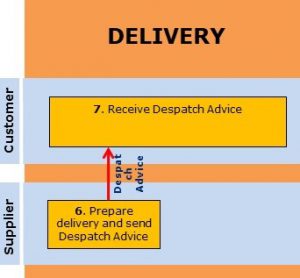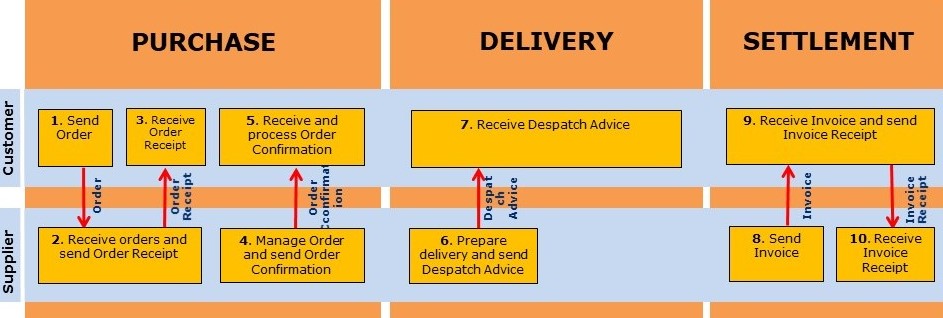5.2 Create documentation, send and receive Despatch Advice
This sub process describes the requirements, recommendations and guidelines STAND has, which may be relevant for the preparation and transmission of documentation for a given delivery.
Essentially, this is related to the Despatch Advice and how it is used for Standard pallets, Mixed pallets, Promotional Units and Customer packed pallets, for these forms of distribution:
- Distributor deliveries
- Deliveries direct to retailer
- Crossdock deliveries
The areas described are:
- General information about requirements for delivery documentation
- Use of EDI in the retail trade and how EDI can be implemented
- Requirements for design and content in Despatch Advice (Message description)
- EDI exchange agreement and how this should be used, to document interaction related to the exchange of the Despatch Advice
5.2.2 Create documentation, send and receive EDI Despatch Advice

Develop documentation
STAND makes no direct claim to any documentation that will accompany or document a delivery, as well as the fact that the EDI Despatch Advice is always to be used for distributors or Crossdock deliveries.
For deliveries direct to retailer, there should bilaterally be agreed if the EDI Despatch Advice is to be sent.
It is nevertheless understood that there may be a need for documentation beyond this, such as consignment, transport documents or other accompanying documentation.
In certain types of deliveries or in given situations there may also be legal requirements for which documentation that shall follow the shipment.
The parties must bilaterally agree what documentation is required in addition to the EDI Despatch Advice.
Send Despatch Advice
When the supplier has picked, labelled and clarified delivery for pick-up (at delivery condition Ex Works) at the agreed time and place, the Despatch Advice shall be sent in accordance with deadline.
One Despatch Advice should only include one order. Exceptions to this may occur at Crossdock.
The Despatch Advice should refer to previous orders.
Despatch Advice shall contain only the products and the quantity delivered.
Exceptions to this may occur at Crossdock, but this must be agreed bilaterally.
Distribution Units (DU) must be identified with SSCC (Serial Shipping Container Code) and this information must be sent in the Despatch Advice.
SSCC is the most important tracking key and associates the individual products in the delivery up to which pallet products are located.
The Despatch Advice is shipped with different details of information, depending on which pallet type the delivery consists of or what has been agreed bilaterally.
Normally, what applies:
- Standard pallet must be sent at level 3
- Mixed pallet must be sent at level 3
- Customer packed pallets must be sent at Level 4
- Promotional Unit must be sent at level 4. Level 3 can be agreed bilaterally
For Promotional Units, the following formulation applies from STAND:
«The grocery industry has a common goal that all deliveries should be traceable as far as possible through the entire value chain. For Promotional Units, this is achieved only by labelling each Promotion Unit with a unique identifier (SSCC) and include it in the Despatch Advice sent to the retail chain. This ensures traceability all the way to the store.
Today, it is variable practices in suppliers on which level of Despatch Advice is used on Promotional Units. The goal is that the industry part will prepare the systems for sending and using Level 4 of Despatch Advice on Promotional Units before the end of 2019 ».
For those who use TakeCargo for transport, the following applies:
- The sender’s consignment number must be sent in the Despatch Advice.
- In Norway, GS1 GINC (Global Identification Number for Consignment) is used as the unique identification of the individual consignment. Documentation of structure can be found at gs1.no.
- The GS1 GINC is preferably used by the transporter. From the the customers, a transport instruction is sent to the carrier (via TakeCargo) which describes the shipment itself. In the transport instructions, the GS1 GINC must be included. It is a requirement that the GS1 GINC sent in the Despatch Advice message is also affixed to the transport documents handed over to the carrier when the products are collected.
Despatch Advice can also be sent to the load carrier (eg NLP) with information about the number of pallets of each pallet type included in the pallet exchange scheme.
This information enables automatic pallet balance update between customer and supplier.
The use of a Despatch Advice for the update of cargo information must be agreed with a cargo carrier before it is taken into service.
The Despatch Advice can also indicate the number of pallet places the delivery requires in transport. This information allows the distributor at Ex Works to calculate the transport needs, thereby sending the correct size of the lorry when the delivery is to be picked up.
Receive Despatch Advice
Upon receipt of a Despatch Advice, the customer can plan and prepare products receipt.
The use of Despatch Advice simplifies products receipt and contains, in addition to other information, traceability information on the products.
The Despatch Advice number must be unique to each Despatch Advice sent from the supplier.
The buyer shall reject a Despatch Advice with a number that has been received and processed earlier.
How the Despatch Advice is used by the customer in internal systems is not covered by STAND guidelines.

